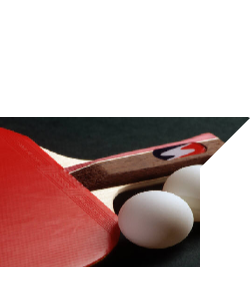



Shopping Cart
Note: All prices in US Dollars
Featured Products
|
|
Like many other sports, table tennis began as a mild social diversion. Descending, along with lawn tennis and badminton, from the ancient medieval game of tennis. It was popular in England in the second half of the nineteenth century under its present name and various trade names such as Gossima and Whiff-Whaff. After the name Ping-Pong (an imitation of the sound made by the ball striking the table and the vellum bats that were used) was introduced by J. Jaques & Son, the game became a fashionable craze. There are many contemporary references to it and illustrations of it being played, usually in domestic surroundings. By the early years of this century, Ping-Pong had already acquired some of its present day complexities, though it was still seen by many as an after -dinner amusement rather than a sport. An account published in 1903 found it necessary to warn against wearing a dress suit and stiff shirt-or, for ladies, a white satin gown-but went on to give detailed technical advice about pimpled rubber, the penholder grip and tactics. 
The game was popular in Central Europe in 1905-10, and even before this is a modified version had been introduced to Japan , where it later spread to China and Korea. After a period when it had dropped out of favor in Europe, the game was revived in England and Wales in the early twenties. by that time 'Ping-Pong' had been registered as a trademark, so the earlier name of table tennis was re-introduced. National associations were formed and standardization of the rules began, both in Europe and the Far East. Then, over the next sixty years, table tennis developed into a major worldwide sport, played by perhaps thirty million competitive players and by uncountable millions who play less seriously. However, the game itself has not changed in essence since its earliest days, though it is faster, more subtle and more demanding than it was even only twenty years ago. a constant concern of the ITTF has always been to insure that table tennis remains a contest of human skills and that technological developments which add a new factor to the game do not give too great an advantage to the players who have the first opportunity of making use of them. Thus, equipment specifications are carefully laid down, and rigorously enforced. Other changes-a lowering of the net, a rule to avoid protracted games between defensive players, and rules preventing excessive advantage being gained by the server-were introduced in the thirties and further minor changes are made from time to time. Changes to the rules of the sport can only be made only at the ITTF's Biennial General Meeting, and are never made without the agreement of a substantial majority of the hundred or so member Associations represented at the BGM, all of whom have an equal vote. Modern table tennis at national and international level is a rigorous as any sport in its demands for the highest degree of physical fitness and mental concentration, attained only by arduous training to develop natural skill. Fred Perry, World Men's Singles Table Tennis Champion in 1928-29, later achieved even greater fame at Wimbledon; perhaps it would not be quite true to say that he moved to the larger court when his play became too slow for the table, but it is certainly true that no sport requires faster reactions and more delicate muscular co-ordination than table tennis. - International Table Tennis Federation museum |
|||||||
info@tabletennisstoreonline.com |
|||||||||